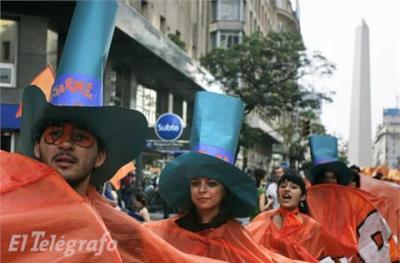|
|
The World Starts the New Year with a Call for Peace
un articulo por El Telégrafo, Guayaquil, Ecuador, December 31, 2009 (unofficial translation from Spanish)
After three months crossing the five continents, the World March for Peace and Non-violence is finishing in Argentina.
The groups of the World March for Peace and Non-violence are now joining up in two Latin American countries, previous to the culmination of the event this Saturday in the Argentine locality of Punta de Vacas, at the feet of Aconcagua mountain on the border with Chile.
 A group of young people participated, Tuesday, in the World March for Peace and Non-violence along Avenida de Mayo in Buenos Aires. A group of young people participated, Tuesday, in the World March for Peace and Non-violence along Avenida de Mayo in Buenos Aires.
photo by El Telégrafo
One of the groups, the one that entered by the Pacific, is in Chile, and the other, whose route was the Atlantic, in Argentina. In the first country, the delegation visited Villa Grimaldi, a former torture under the dictatorship of Augusto Pinochet (1973-1990).
In this place, that was re-baptized as the Park of Peace, the Letter for a World without Violence, written by the Nobel prize winners meeting in Germany was signed, in past November. This document was also subscribed to by authorities and artists during the route of the world-wide march around ninety countries in the five continents.
The march initiated in Wellington (New Zealand), the past 2 of October, and has taken place through Southeast Asia, India, Europe, Africa, the United States, Mexico, Central America and several countries of South America, including Brazil, Ecuador, Colombia, Bolivia and Peru.
According to the organizers, the objective of the event is to awaken world-wide consciousness on the necessity of a world without war or violence, with proposals like nuclear disarmament, the abandonment of occupied territories, the progressive reduction of conventional armaments and the resignation by governments of the use of the force.
The Spanish humanist Rafael de la Rubia, general coordinator of the march, was received in Santiago by the Chilean NGO World Without War and was an illustrious guest of the Chilean capital declared yesterday by the mayor, Pablo Zalaquett.
The group of the World March for Peace and Non-violence participated yesterday in a carnival by the main streets of the center of Santiago, headed by the minister of Chilean Culture, Paulina Urrutia, to arrive at the Palace of the Currency, where the members of the initiative were received by the president, Michelle Bachelet.
The members of the international event that is in Chile planned a major free concert with Argentine artists Pedro Aznar, Caesar Isella, Victorio Menghi and Cristian Soloa, as well as the Chileans Inti Historical Illimani, Piedra Lucybell, Pig and Florcita Motuda, among others.
The other group of the world-wide event that traveled by the Atlantic arrived Tuesday at Buenos Aires (Argentina), where they were received by the president Cristina Fernandez.
|








|
DISCUSSION
Pregunta(s) relacionada(s) al artículo :
How effective are mass protest marches?,
* * * * *
Comentario más reciente:
Hi.
I have two comments about this report. The first is on the question about the effectiveness of mass protest marches.
Recalling the effectiveness of mass protest marches in the 1978 Iranian Revolution, I looked it up on a search engine and found the following account of the revolution's climax"
"In November, the Shah turned the government into a military government in order to force strikers back to work. But the worst, everyone knew, was about to come. The month of Muhurram was approaching, the month in which Shi'ites traditionally celebrate the martyrdom of Husayn. It is a passionate and highly religious month, and since the protests against the Shah were largely religious in nature, everyone knew that the country was on the verge of exploding.
Muhurram began on December 2 with demonstrations, and these demonstrations would continue all throughout the month. They were massive, in the millions, and it was clear that the demonstrators, not the government, was in charge. . ... continuación.

|
|


 A group of young people participated, Tuesday, in the World March for Peace and Non-violence along Avenida de Mayo in Buenos Aires.
A group of young people participated, Tuesday, in the World March for Peace and Non-violence along Avenida de Mayo in Buenos Aires.





